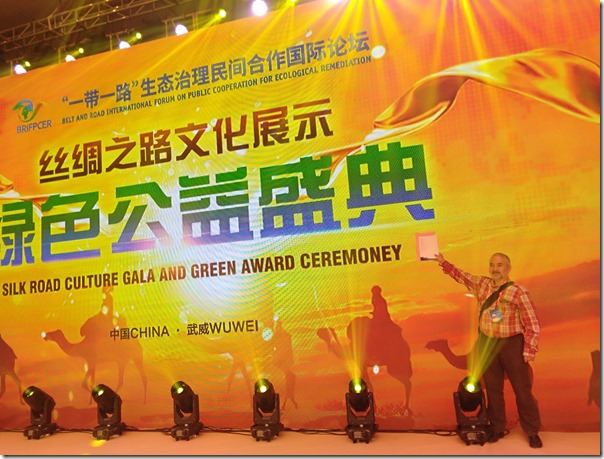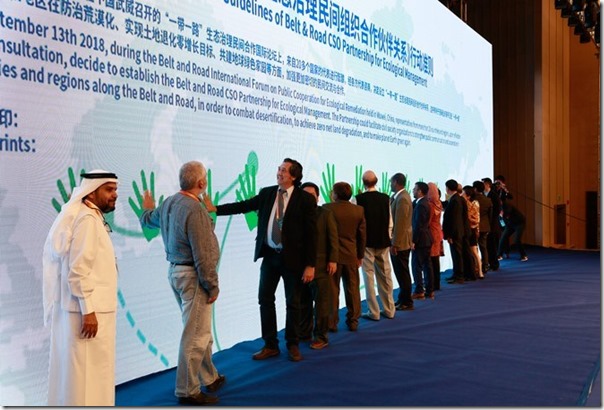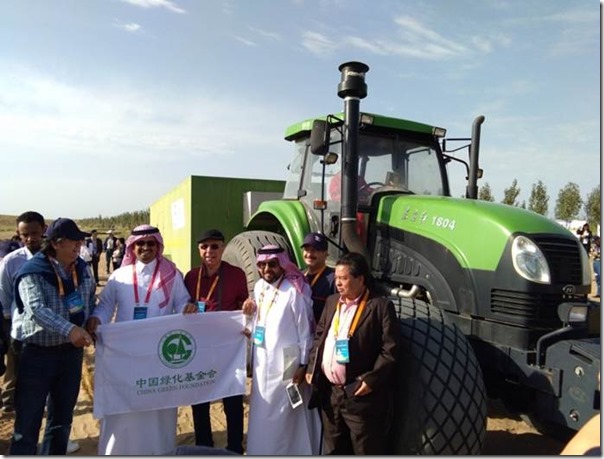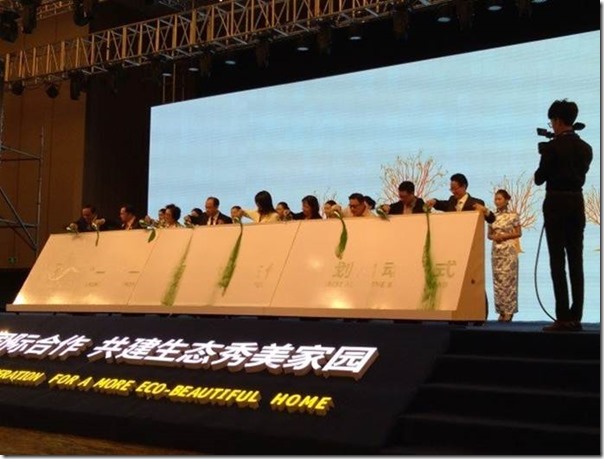A Glimpse of China’s “People to People” cooperation along the Belt and Road
Among the five pillars of China’s Belt and Road Initiative (BRI), “promoting people to people connection” is probably the least well understood, not just because of the intangible nature of such cooperation in general (compared with huge “connectivity” projects such as railroads and ports that are concrete in its literal sense), but also because traditionally China is often seen as lacking the kind of soft power needed to genuinely engage with the “hearts and minds” of the public in other countries.
Recently, Eugene Simonov, a Russian environmentalist and a friend of the Panda Paw, Dragon Claw blog, had the rare opportunity to participate in the “Belt and Road International Forum on Public Cooperation for Ecological Remediation” held from September 11-14 in Wuwei, Gansu, a drought-stricken province of Western China bordering the Gobi Desert.
Founding of the “BRI NGO Partnership for Ecological Management” (actual objectives and program are yet to be defined), Photo supplied by Eugene Simonov
The event was jointly organized by the China Green Foundation (CGF), China NGO Network for International Exchanges, and the International Forestry Cooperation Center of the National Forestry and Grassland Administration (FGA), a mixture of governmental and semi-governmental bodies charged with the task to advance “people to people connection” through environmental collaboration.
Compared with more traditional forms of accepting international students and training developing country bureaucrats, the “Green BRI” initiative, if played well, could kill two birds at once: finding an area of “people to people” cooperation that can tap into a rich pool of existing exchanges between Chinese environmental NGOs and their foreign counterparts, while reinforcing China’s “green leadership” image internationally.
As Eugene’s account shows, however, the reality is far from ideal. In many aspects the event appeared well-intentioned, but too orchestrated and somewhat awkward. Genuine engagement with BRI region civil society on environmental sustainability apparently requires Chinese actors to change their modus operanti. And the rare occasion also gives BRI country NGOs a chance to learn how to approach the Green BRI initiative.
“So I had to represent Putin.”
Panda Paw Dragon Claw(PPDC): So how did you end up at this extravagant Green BRI event in Gansu?
Eugene Simonov (ES): Foreign participants like me were invited for various reasons not necessarily related to the key theme of the event or our NGOs’ experience with the BRI. It is worth noting that two thirds of the Forum participants were Chinese FGA officials and experts, as well as functionaries of local party committees. About 15 foreign NGOs from various countries were invited, mostly with the help of the United Nations Convention for Combating Desertification (UNCCD) secretariat, as well as up to a dozen representatives from Chinese branches of international environmental groups (WWF, IFAW, NRDC, etc). Local grassroots NGOs from China’s desertification-stricken areas were neither seen or heard at the Forum.
The largest NGO delegation was the Saudi Desert Plant Cooperation Society headed by His Highness Prince Muteb. Photo supplied by Eugene Simonov
In my case, I was recommended to CGF by an Indian colleague, to whom I was accidentally recommended by Rivers without Border (RwB) Mongolia when asked to find a “representative of Russia”. So I had to represent Putin, sitting at table no.1 with key cadres at banquets, rub shoulders with His Highness Prince Muteb from Saudi Desert Plant Society, and to the extent possible, behave myself.
PPDC: The Chinese government isn’t really known for its engagement with civil society groups. What’s your impression of attending a government organized NGO gathering in China?
ES: Having uneven support from governments and local communities in BRI regions and being criticized by foreign press for lack of consultation in project planning, China is eager to demonstrate its willingness to build cooperation with NGOs in BRI countries.
In particular case of this Forum, the Chinese authorities did not seek recommendation or approval from the respective governments of BRI countries to interact with foreign NGOs, which goes beyond the “government-centric mentality” expected from them. So I see it as a progressive approach and a sign of openness.
On the other hand, little effort is made so far to engage NGOs in joint planning and/or at least to get feedback from them on proposed cooperation plans. They were largely there to “demonstrate support for Green BRI” and at best seen as implementers of already proposed projects. When NGOs expressed doubts they were reminded that it’s their own decision whether to continue such cooperation. This is very similar to mode of official bilateral negotiations with China on many “joint projects”.
“Exporting green solutions like exporting industrial capacity”
PPDC: The “Green BRI” initiative, first announced in May 2017, always feels a bit vague and empty. Does the event give you any concrete idea as to what China is trying to achieve?
ES: The event shows how China’s newly established Forestry and Grassland Administration (FGA) would likely advance the initiative.
The Forum was a follow-up to the UNCCD conference held in China last year. At that conference, China made a pledge to combat desertification and “to carry out cooperation on ecological restoration” along the Belt and Road.
On the first day of the event the organizers arranged a day-long field trip to desertification control project sites of Gansu Province. We toured experimental bases of various companies designing desert-combatting technology, state-owned orchards and vineyards in oases, and poplar plantations. From the bus we only glimpsed the edge of the beautifully natural Tengger Desert, the advance of which all these fortifications are being designed to slow down.
At the Forum, Secretary General of CGF, Mr. Chen Peng, made a detailed introduction to the project “Restoration of Populus Euphratica Forest Eco-system along the Belt and Road”, which was offered as the key practical contribution to “greening BRI” by the CGF and FGA.
This poplar is one of the keystone species of riparian forests at vast floodplains of Central Asian and Middle-Eastern rivers from Tarim and Indus to Amu-Darya and Euphrates. FGA believes the poplars provide important economic value to people (erosion control, fodder, tourism, wood, firewood, medicine, etc). Under the plan, a cooperative partnership will be established with local NGOs to encourage more exchanges of experience in different countries with Euphrates Poplar as a symbolic keystone species. Most activities so far are planned, however, in Xinjiang and across Northwestern China.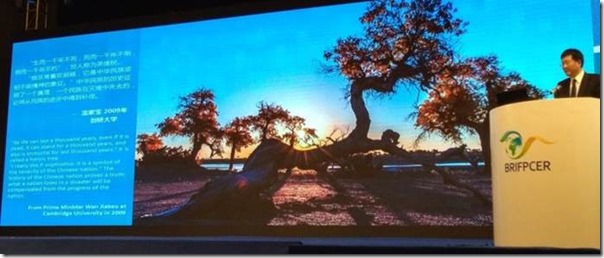
Slide quotes: “Populus euphratica (Hu Yang) is a symbol of the tenacity of the Chinese nation…” Premier Wen Jiabao, 2009, Photo supplied by Eugene Simonov
PPDC: So it sounds like a massive tree-planting effort along the Belt and Road?
ES: It’s slightly more than that. During the forum, the GCF also announced the launch of an international ecological restoration fund, drawn from donations from companies worldwide to promote a green economy in countries involved in the BRI. First pilot project for poplar planting abroad is planned in mountains of Pakistan along the China Pakistan Economic Corridor (CPEC), but I found no Pakistani representative at the Forum or among the listed editors of the very detailed bilingual report “Restoration of Populus Euphratica” handed out to participants.
Dozens of Chinese companies, including the very famous ELION Group which has been celebrated for its anti-desertification efforts in Kubuqi Desert, were featured heavily at the event. The whole thing makes me feel that the logic for doing such “Green BRI” projects is quite similar to the logic behind “industrial capacity sharing” along the Belt and Road, i.e. exporting Chinese industrial capacities such as power plants and steel mills to other countries. China has some mature desertification-control technology, buttressed by domestic success stories and may be shared and exported with some involvement of China companies. Whether or not the marketed approach fits local needs, ecological conditions and social demands is to be studied AFTER overall project direction has been identified.
Like high-speed railways and other “exported capacity”, success of such projects directly depends on how they match local conditions. Strategic planning and public consultations are straightforward means to increase likelihood of success. So far those tools are rarely used in early planning of BRI projects and “capacity sharing” programs.
PPDC: Were there reservations expressed at the event about this approach?
ES: First of all, I must clarify that I do not disagree with necessity to plant trees. And I see great necessity to restore natural multi-species riparian forests in Central Asia. But similar to many other scientists, I tend to view with great suspicion tree-planting projects in deserts and steppes which naturally do not support woody vegetation, unless it is done due to extreme economic need and in environmentally sustainable manner. Water availability and equitable access to its use is the key factor on which adaptation strategy in a given place depends on. For example, the key to restoration of riparian forests is in preserving adequate flooding by respective rivers and controlling grazing and other activities that suppress tree growth. Artificial planting is only a supplementary measure, especially in places where seeds from trees are not available naturally.
From all foreigners who came to the forum, only Meskele Lera Lencha, the officer of the Hailemariam and Roman Foundation from Ethiopia called China to support large-scale tree-planting endeavors overseas. Other foreign participants had stressed different priorities such as local community empowerment and diversification of local economies.
Even tree-planting champions like the very articulate John H. Kwon from Korean Future Forest, which plants forests in China’s easternmost deserts, explained that planting efforts alone cannot catch up with the speed of land degradation, and preventative policies and measures are essential to win the battle.
PPDC: Did you weigh in on the debate?
ES: At the event I attempted to describe long-term cooperation in China-Mongolia-Russia Dauria International Protected Area, where government agencies, scientists and NGOs complement each other. I emphasized priority of protection measures and strategic science-based environmental assessment of any development and climate adaptation project. Interesting enough, my pitch was immediately echoed by the Head of the FGA Grassland Management, who stated that the main task of desertification control is to prevent conversion of the desert margins into arable land during wetter phases of climate cycle.
Other than delivering our speeches and remarks from the podium (by the way, completely uncensored, which is another good sign of the Forum’s openness) we had not any other slot where we could actually discuss issues and plans.
“Very straightforward recommendations should be repeated again and again.”
PPDC: As an NGO participant, how do you envision this project to unfold hereafter?
ES: Except for the “Euphrates Poplar Project” there is no publicly available overall plan for advancing the cooperation outlined at the event, at least in the realm of FGA activities. Likely what will happen is “development aid” type of cooperation where partners are sought to implement predetermined projects and resources are distributed to consortiums of Chinese actors and foreign NGOs.
Developing countries have large number of NGOs for which distributing foreign aid for predetermined projects is the main mode of operation. So the approach is theoretically doable, but hardly the most effective or innovative. And most NGOs invited to this Forum are not likely partners for such an endeavor, as they are generally mature enough to formulate and execute their own programs best fit for specific local conditions. We are yet to see whether partners from China are willing to engage in a dialogue with local stakeholders and redesign predetermined projects. If you want another forest plantation, it is logical to go to local Forestry Departments in BRI countries instead of NGOs.
At the end of the Forum, International NGOs were given bottles with shiny green liquid to poor it over a large poster revealing the name of the new-born “Belt and Road Euphrates Poplar Forest Ecological Restoration Plan and International Cooperation Fund on Ecological Management”. Photo supplied by Eugene Simonov
PPDC: What would be the more effective ways then?
ES: Hopefully FGA, which has key responsibilities in nature conservation and ecosystem management, will be able to start other lines of cooperation with foreign NGOs, for example to prevent destruction and degradation of valuable and vulnerable wildlife habitats, which happens because of many reasons, but increasingly due to poor planning and management of BRI projects. However, no sign of that was seen at the Forum. It was dedicated fully to “remediation” after damage is done.
It is especially urgent along the Silk Road Economic Belt (SREB) where arid conditions make huge portions of natural and semi-natural landscapes very vulnerable that need preventative measures. In early Green BRI policy documents and associated research project outcomes, it is openly said that identification of valuable and vulnerable areas and preventing their degradation is an urgent task.
Strategic environmental assessments (SEA) are among most needed and accessible tools, since they are written into in legislation of China and most BRI countries.
PPDC: Do you find this experience overall worthwhile?
ES: Sure, meeting so many natural resource management actors from national to very local level was very useful experience. It is necessary to participate in such official fora to keep channels of communication open. Although not very effective, such channels are much better than absence thereof. And at those occasions, very straightforward recommendations should be repeated again and again publicly on strategic planning, good governance, meaningful performance indicators and open information, even though you may not get meaningful response immediately.
When it comes to specific pilot projects in their countries foreign NGOs may link Chinese actors with interested and knowledgeable local stakeholders, or at least help local communities to prepare for projects coming their way. This Forum could have achieved more if it was multi-stakeholder. A mix of academicians, NGOs, indigenous leaders and forestry officials from various BRI regions would provide better matching opportunities and ensure greater acceptance for future joint projects.
Source Panda Paw, Dragon Claw blog


